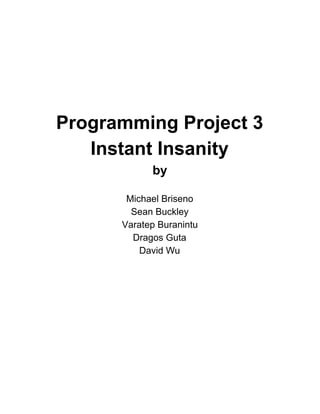
InstantInsanityProgrammingAssignment
- 3. Python implementation of pseudocode: 1. def compareIt(arr, genList): 2. for i in xrange(len(arr[0])): 3. genList[i] = arr[0][i] #store the first pair 4. print("First stored pair:",genList[i]) 5. recurse(arr, 1, genList) # recurse to the next line 6. 7. def recurse(arr, ind, genList): 8. if ind == 40: 9. print ("Solution is: ",genList) 10. else: 11. #print("hit else") 12. for i in xrange(len(arr[ind])): 13. #print("i is ",i) 14. #print ("array pair: ",arr[ind][i]) 15. pair = arr[ind][i] #select a pair 16. for i in xrange(ind): #select each previous line in genList 17. #print("current genList is: ") 18. for r in xrange(ind): 19. print(genList[r]) 20. #print("pair[0] is ", pair[0], "genList[i][0] is: ", genList[i][0]) 21. if pair[0] != genList[i][0]: 22. #no problem, check other item 23. if pair[1] != genList[i][1]: 24. #no problem, add pair 25. genList[i+1] = pair 26. #print("Recursed") 27. recurse(arr, ind+1, genList) 28. else: 29. #problem, don't add 30. c = 0 31. #endif 32. else: 33. #problem, don't add 34. c = 0 35. #endif 36. #endfor 37. #endfor 38. #endif 39.#end recurse Analysis The time complexity of this algorithm is O(n^4). In order to reduce the actual execution time of the program, a Hadoop cluster could be used with an advanced message queue protocol such as RabbitMQ. RabbitMQ can be used to distribute bits and pieces of the required computation to separate machines in each cluster. Hadoop is used for distributing processing power and computations of a large data set throughout multiple clusters of computers. The execution time of an optimized algorithm then relies heavily on how much computational